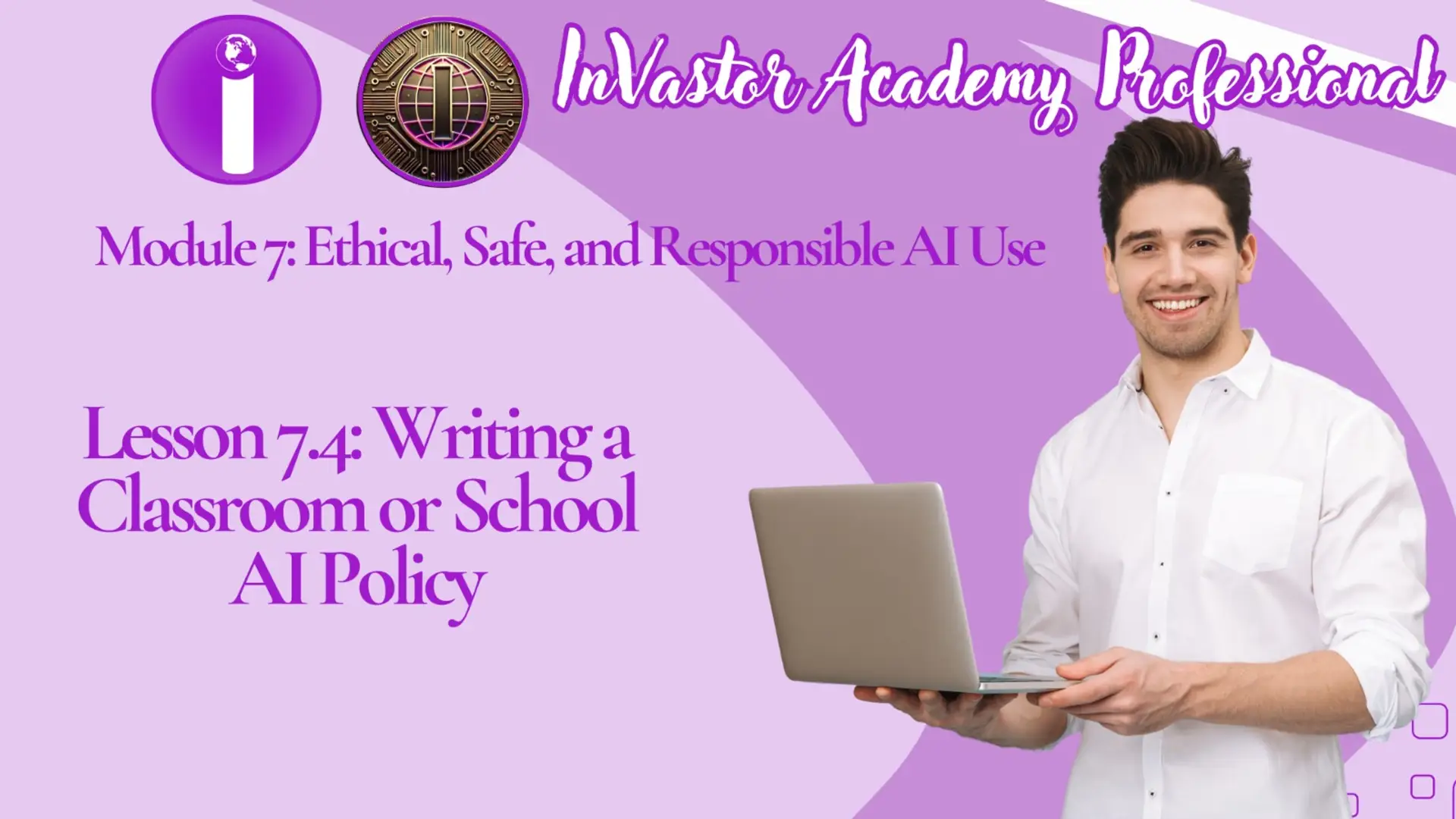

Module 7: Safety, Privacy, and Responsible AI Use in Education Lesson 7.4 — Writing a Classroom or School AI Policy
Module 7: Safety, Privacy, and Responsible AI Use in Education
Lesson 7.4 — Writing a Classroom or School AI Policy
Learning Objectives
By the end of this lesson, educators will be able to:
- Explain the purpose and importance of an AI use policy in educational settings.
- Identify the key components of an effective classroom or school AI policy.
- Draft guidelines that align with district, state, and federal regulations on data privacy and ethical AI use.
- Collaborate with stakeholders (administrators, IT, students, parents) to develop transparent AI expectations.
- Model responsible AI integration practices that prioritize equity, safety, and trust.
1. Why Schools Need an AI Policy
AI tools are becoming common in classrooms — from grading assistance to lesson planning. Without clear policies, schools risk:
- Violating data privacy laws (FERPA, COPPA, GDPR).
- Introducing bias or misinformation into learning materials.
- Creating inequities among students with unequal access to technology.
- Damaging trust between families, students, and educators.
A well-written AI policy ensures consistent, transparent, and ethical AI practices across your school community.
2. Core Principles of a Strong AI Policy
An effective AI policy should reflect the following principles:
When developing or adapting an AI policy, include these sections:
1Purpose and Scope
- Why the policy exists and who it applies to (teachers, staff, students).
2.Approved and Prohibited Uses
- Specify acceptable classroom applications (lesson planning, translation, accessibility).
- List prohibited uses (grading students solely by AI, uploading student data).
3.Data Privacy and Security
- State compliance with FERPA, COPPA, GDPR, and local laws.
- Require anonymization of all student data.
4.Equity and Access
- Ensure fair access to district-approved AI tools.
- Address accommodations for students without internet or device access.
5.Transparency and Communication
- Require teachers to inform students and families when AI tools are used.
6.Ethical and Responsible Use
- Promote bias awareness, critical evaluation of AI outputs, and respect for intellectual property.
7.Training and Support
- Provide ongoing professional development for educators.
8.Monitoring, Reporting, and Review
- Define procedures for reviewing compliance, handling violations, and updating policies annually.
4. Template: Classroom AI Policy Statement (Example)
Classroom AI Use Policy — Mrs. Nguyen’s 8th Grade ELA Class
Purpose:
AI tools will be used to enhance learning and creativity while maintaining student privacy and safety.
Guidelines:
- I will not input student names, grades, or identifiable information into any AI tool.
- I may use AI to brainstorm lesson ideas, generate writing prompts, or create rubrics.
- All AI-generated materials will be reviewed and edited by me before classroom use.
- Students may use district-approved AI tools for research and writing support after receiving instruction on ethical use.
- Any student work created with AI assistance must include an acknowledgment of the AI tool used.
Compliance:
This policy aligns with district data privacy and technology guidelines. Questions about AI use will be directed to the technology coordinator or principal.
5. Steps to Develop a School-Wide AI Policy
- Form a Committee — Include teachers, administrators, IT, parents, and students.
- Review Legal Requirements — Align with FERPA, COPPA, GDPR, and state laws.
- Audit Current Practices — Identify where AI tools are already being used.
- Draft the Policy — Use the key components above as a framework.
- Seek Feedback — Share drafts with staff and community members.
- Train and Communicate — Provide staff workshops and parent letters.
- Implement and Monitor — Review policy effectiveness annually.
6. AI Policy Writing Checklist
Before finalizing your policy, confirm that it:
✔ Clearly defines AI use and scope.
✔ Addresses data privacy and consent.
✔ Promotes transparency and equity.
✔ Assigns accountability for oversight.
✔ Includes professional development and periodic review.
7. Supplementary Resources
How is artificial intelligence (AI) used in education?
What Are The Essential Elements Of A School AI Policy? - Safe AI for The Classroom
How Does Responsible AI Integration Affect Equity in Learning Opportunities?
Lesson 7.4 Quiz
Writing a Classroom or School AI Policy
Complete the quiz to check your understanding of policy development and ethical frameworks.
You must score at least 70% to pass.
Click here for Quiz 7.4
Conclusion
Creating an AI policy isn’t just a compliance task — it’s an ethical commitment to protect students, empower teachers, and guide the responsible use of technology.
A strong AI policy:
- Promotes trust and transparency.
- Ensures safety and privacy.
- Encourages innovation with integrity.
Responsible AI begins with clear expectations, consistent practice, and collaborative leadership.
Next and Previous Lesson
Next: Module 8 —The Future of AI in Education
Lessons:
8.1: Future Trends (Adaptive AI, Emotion-Aware Learning, Autonomous Tutoring) Promoting AI Literacy Among Students
Previous: Lesson 7.3 —Protecting Student Data and Following Legal Guidelines
AI for Educators: Personalized Learning & Content Creation
Related Posts
© 2025 Invastor. All Rights Reserved


User Comments